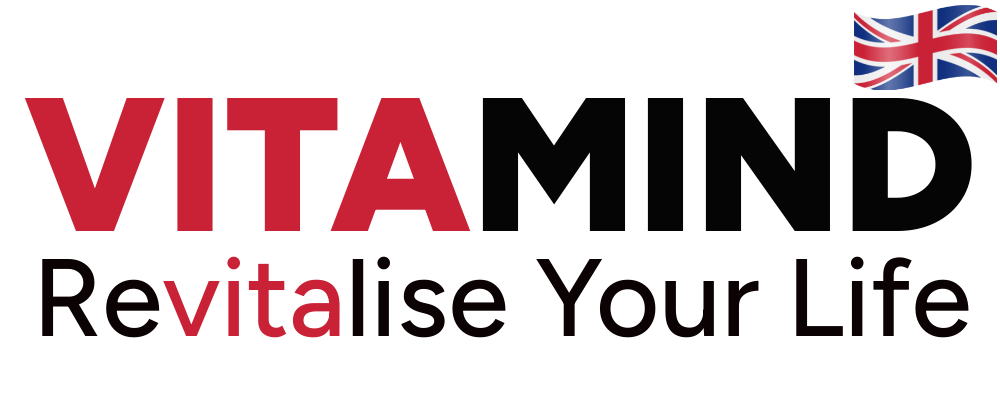It’s never too early to reach for a babyproofing checklist! Your baby approaches her environment with curiosity. That is understandable because everything is new and unknown and exciting. Anything she can reach, she will touch and pull it up and down. This is quite a challenge for you as parents once your baby has learned to roll from back to tummy (and/or vice versa), but as soon as she can crawl and your home becomes her research area, it’s time to make your home completely childproof.
Your ultimate babyproofing checklist
Here is a checklist of what you should pay attention to in the household and around your furniture. Walk into your home and “defuse” possible traps before your baby can injure herself.
Statistics show that 70% of accidents happen at home. Around 60% of these accidents could have been prevented. One reason for many accidents is that parents are not aware of the dangers or underestimate them. Usually the risk of accidents on the road is considered to be much higher than that in one’s own four walls.
Dangers lurk in every room of a house or apartment that we, adults, do not notice. It is therefore best to consciously take your child’s perspective. This automatically results in a lot of danger spots that you did not have in view before.
In order to support you in making your home child-proof and in preventing it in good time, we have created a checklist for you based on the motto “See dangers, understand, prevent”.
For each room you will find safety tips, information on the most common danger spots and suitable solutions.
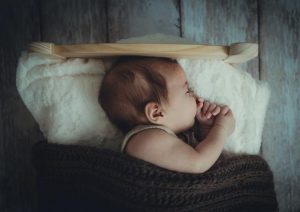
Babyproofing checklist for the nursery
Attach shelves to the wall
There are also dangers lurking in the children’s room, for example in the form of shelves that can tip over if children pull themselves upon them. Chests of drawers in which the drawers can be opened easily are also used for climbing and can kill your child. It is therefore imperative that you attach cabinets, shelves, and chests of drawers to the wall.
Secure the cot
You should remove all mobiles and music boxes from the bed and from the bed so that your child sleeps safely even when they are already a bit more agile. If your baby can already pull himself up on the bars, be sure to put the bed on the lowest level. Avoid too soft mattresses, bedding, bumpers, and too many toys in the cot.
Babyproofing the cot
- Do not place your child on very soft, fluffy bedding such as pillows, blankets or sheepskins to sleep.
- Once your baby is able to turn on all fours, remove mobiles and hanging toys.
- As soon as your baby can pull himself up on the railing, you should put the mattress on the lowest level.
- Remove toys from the crib when your baby and you sleep.
- Seal off the entrance of the bed when you are not in the room.
Babyproofing the changing table
- Do not leave your baby unattended on the changing table.
- Keep toiletries where you can reach them but your child cannot.
If a bunk bed is used, it is worth securing entry. You should also briefly think about whether dangerous objects near the bed should be removed or secured. In this way, the risk of a fall can be further reduced.
Changing tables should have a frame so that the child cannot simply fall off. If you build a changing table yourself, you should also pay attention to this frame. The surfaces should also be slip-resistant and should not have any sharp edges.
Night lights, which should not only be installed in the children’s room but also in the hallway and up to the parents’ bedroom, provide additional security.
Babyproofing checklist for safety in living room
Close the sockets
Some aspects of security apply to all rooms. This includes the socket fuse. Thanks to a child safety lock with a twist mechanism, you can continue to use the sockets and your child does not run the risk of getting injured. The easiest way is to install childproof plugs which simply clip into the socket when the socket is not in use. A residual current circuit breaker would be even better. Despite fuses, however, you should make sure that your child does not reach the power sockets.
43.4% children hospitalized for home injuries are under 5 years of age. The proportion of children under the age of 1 was particularly high.
Attach shelves and cabinets to the wall
As already mentioned in the children’s room section, all wardrobes and chests of drawers should be securely attached to the wall (make sure that the type of dowel and screw size are correct). You will not be able to pay attention every second. Accidents can happen as soon as your child starts pulling themselves up on furniture.
- Place the TV on a low piece of furniture and slide it as far back as possible.
- Hide wobbly lamps behind furniture.
Place potted plants out of reach
Drooping parts of the plant invite you to pull. Quite apart from the toxicity of most houseplants: if the flower pot then rushes down, it can turn out really bad. So make sure that your child cannot reach the tendrils, leaves, or aerial roots. Flower pots should be so secure that even a wobbling cupboard won’t let them fall down.
Secure furniture edges
Bumping into the edges of furniture is uncomfortable and can lead to lacerations and bumps on the head. Children are often not yet able to correctly assess distances and in the heat of the moment do not notice obstacles until very late. Therefore, secure all sharp furniture edges with an edge protector (saliva-proof and free of harmful substances) that is attached to the corners.
Make the windows and doors really safe
One hears again and again about children who did not survive falling out of a window. It doesn’t have to be. Because there are special window and balcony locks so that your child cannot open them on their own.
Also, remove the cords from curtains and make sure that the cords from blinds or shades are hanging out of reach. A doorstop is recommended for the door so that fingers cannot be trapped.
Secure pull cords on window decorations
Operating cords on window decorations pose a further health risk, as in the worst-case children can strangle themselves from them – as fatal accidents in the past have shown.
Since 2014, manufacturers have therefore been obliged by the EU standard for the safety of children to equip every internal sun protection that can be operated with a cord with child safety devices.
Always provide stairs with gates and bars
Do not underestimate the danger of stairs, because children are quick and falling downstairs is plain dangerous. With the help of a stair gate, you can get rid of this source of danger.
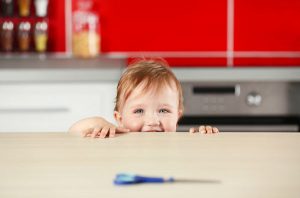
Babyproofing the kitchen
Kitchens are very attractive to children, not only because their parents spend a lot of time there, there are also some delicacies hidden here. Unfortunately, there are also many dangers.
The kitchen with the hot stove and sharp knives can lead to dangerous situations. Therefore, install the stove guard and don’t leave knives lying around.
Check electrical devices and keep them out of the reach of children.
Hot plates can cause devastating burns. Therefore, when children are present, you should only use the rear stove top or attach a stove guard. This reliably prevents children from reaching up and getting burned or throwing down a hot pot.
Oven doors are often responsible for accidents with babies and young children. The handle literally lends itself to pulling yourself up; if the flap opens, the child can quickly injure themselves. If it does not open, the child may climb up onto the kitchen surface.
Babyproofing the dinner table
A tablecloth on a dining table can be easily pulled down, allowing objects on the table to fall on the child. You should therefore avoid tablecloths or fasten them securely to the table with clamps. Of course, no dangerous objects should be left on the table when nobody is around.
Babyproofing kitchen cabinets
Kitchen cabinets are very tempting for toddlers. Unfortunately, this also presents many dangers. This includes:
- Dangerous objects in it (cleaning supplies, cutlery, scissors, kitchen tools)
- Trash cans (poisonous and rotten things) plus can serve as a climbing aid
- Drawers can fall out and also serve as a hiding place
- Heavy objects can fall down
You can protect your baby with special devices that prevent cupboards and drawers from opening.
Babyproofing windows and window sills
- Remove hanging cords from curtains and shutters.
- Mark large glass surfaces, such as sliding patio doors, with large, colorful stickers.
- Keep your baby away from open windows.
- Prevent poisoning by insect repellants, scented candles, aroma diffusers, and plant foods.
Eliminate any sources of danger that could poison your baby. These include, for example, cleaning products, medication, cigarette butts, alcohol, or poisonous plants. You can read here how to prevent and treat poisoning.
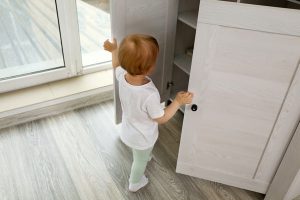
Babyproofing master bedroom
Bedside tables with drawers full of prescription medicines, electrical gadgets, chargers, and other bright and shiny thing are luring toddlers. Baby locks can solve the problem but some things are best stored in boxes high above the baby’s reach.
Why furniture is dangerous and what you can do about it
What applies to kitchen cabinets also applies to all other furniture. The greatest danger is falling when the child has climbed or tried to climb it. This can open drawers or doors, the handles of which are used as climbing aids, or objects can fall down.

Furniture can fall over as a whole, which is why smaller chests of drawers should also be screwed to the wall. A large Swedish furniture manufacturer recently even recalled a chest of drawers because it seriously injured or even killed several children when it fell over.
Idea: lockable medicine cabinet in the bedroom
A medicine cabinet has a number of advantages. For one thing, children don’t come close. After all, many drugs can be fatal for children. On the other hand, the medicines are always easy to find in such a cabinet. If you place it in the coolest room in the apartment (usually the bedroom), the ingredients won’t break easily.
- Toilet lids also pose a risk of entrapment. Therefore you should only use covers with built-in dampers that cannot fall off.
- At the latest when small children become more mobile and walk through the apartment or house, you should also look at the corners and edges. These can be easily defused with an edge protector.
- Glass tables, especially those for the couch, should be avoided. A child climbing on it can easily break through the glass and cut themselves on the glass.
- Carpets that are on slippery floors should always be equipped with an anti-slip device underneath. A toddler who otherwise walks across the carpet can fall quickly.
Babyproofing potential poisons & cleaning supplies
Keep potentially dangerous items, such as cleaning supplies, medicines, and cosmetics, in closed containers or cupboards out of the reach of children.
Poisoning is one of the most dangerous dangers for children in the household. There are many substances that can be used for this:
- Medication
- Cleaning supplies
- Oils (lamp oil, furniture polish, motor oil, etc.)
- Hygiene fluids (tooth rinse, shower gel, etc.)
- Cigarettes, tobacco
- Alcohol
- Poisonous plants
It is imperative that all of these substances be kept out of the reach of babies and toddlers. A few moments are enough and a leaf of a plant or half a bottle of cleaning agent is swallowed. There are several ways to secure boxes and cabinets with such substances.
If poisoning has already happened, proceed as follows:
- Call the responsible poison control center
- No causing vomiting!
- No milk
- Drink water afterwards
Important: The phone number of the poison control center should always be visible. Since poisoning requires very different solutions, you should act quickly and trust the experts.
Your handbag can also be a source of danger if it contains hand sanitiser or sweets that the child could swallow. Make sure to stow all dangerous things safely back in the household. Plastic bags, sewing accessories, clips, or medication are just as much a part of it as batteries, small magnets/pins, change, lighters, and cutlery.

Babyproofing pets and accessories
Many families share their homes with one or more pets. If that is the case with you too, remember to put/hang things like litter boxes, food bowls, leashes, or the like out of reach, if that is at all possible.
Bird or rodent cages should never be placed in such a way that the child can tear them down.
Babyproofing everything electrical
Sockets
- All sockets that are partially accessible for children must be made child-proof. There are two ways to do this:
- Socket inserts: can be used retrospectively and can only be removed with a plug. Therefore a bit cumbersome to use but very safe.
- Sockets with child protection: Must be replaced with the existing sockets. Inside are small plates that close the openings, cannot easily be bypassed.
- When it comes to power distributors, there are models with child locks that should definitely be used.
Cables
In general, no cables should be freely accessible to the child or baby. It can pull itself up and fall, throw down an electrical device, or choke itself on the cord. Where cables cannot be avoided, they can be fastened with cable holders and nail clips and thus secured.
Short-term electrical devices with cables, such as many kitchen appliances or irons, should never be left unattended with the child. Never leave seemingly innocent devices, such as hairdryers, toasters, and other smaller gadgets plugged into the socket and keep them out of the reach of your child.
Charging cables for smartphones or tablets should also be used with caution. There is no risk of electric shock (although putting a plugged-in charging cable in the mouth can be very painful for a baby) because these carry relatively little electricity. However, the thin cables make it easy for the baby to get tangled or choked.
Babyproofing electronic devices
Electrical devices are very often a source of danger for small children. In particular, kitchen appliances or tools must never be left alone with the child.
Flat screens and larger speakers must also be secured so that the child cannot pull themselves upon them or knock them over.
Babyproofing the yard and garden
A garden is a pure adventure for children. So that it stays that way, you should protect all water surfaces (whirlpool, swimming pool, pond, rain barrel) and cover them with special foils. It should be noted, however, that the films must be stable enough that a child who climbs over them cannot break in, otherwise the supposed protection will quickly become a trap. This is achieved with thick foils that do not go under or with stable attachment to the edges.
Babyproofing garden tools
Garden tools should always be safely stowed away. Extreme caution is required when working with heavy or noisy equipment when children are nearby. It is best to have a second adult look after the child during this time.
In the open air, of course, there is also nature as a potential danger, especially when it comes to stinging insects. Small children should therefore never be left unattended outside. Especially not when there is still food involved.
The question often arises as to what you have to pay attention to when you are out and about. Because when you leave the baby-safe apartment, there are suddenly new dangerous situations. For example, road traffic.
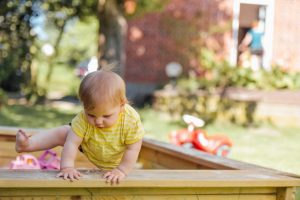
When children learn to walk on their own, you should make sure that they are not yet allowed to run around freely everywhere. They cannot assess distance and speed and are overwhelmed even in traffic. It is hence advisable to keep the toddler in the stroller or in the carrier until they are safe on main roads. And until then, the toddlers shouldn’t be out and about unsupervised, even if it’s the low-traffic street in front of the front door.
It is best for toddlers to first run around freely in the park, forest, meadow, or playground, away from cars, bicycles and the main traffic.
Tips for babyproofing your home
Put yourself in your child’s perspective for a safe home
To understand which objects can be dangerous for the little rascal, put yourself in the perspective of your child and see the world through the child’s eyes. Which objects are within reach, what could be dangerous? This exercise will help you understand how dangerous your baby is on the move. For example, if there is a power socket under the table, it must be secured with a special device for the safety of your child.
Identify the dangerous places
Garage, basement, bathroom, gym, and office can be of particular importance for the livelier children. In addition, you must lock away all closets with detergents, tools, small objects or chemicals to ensure child safety.
Support the first attempts at walking
When the baby is ready to climb the stairs on their own, show him how important it is to hold onto the railing. Also, for the safety of the child, remove any mats or slippery objects that the toddler could trip or slip on.
Conclusion
It is extremely important to observe all safety precautions as a child becomes more and more independent and begins to actively explore the world. After you’ve made all of the standard precautions, don’t be too lazy and look at the babies’ world from their perspective.
Find out whether there are any sharp, invisible dangers hidden in your home that could endanger baby safety. Make sure your child grows up in a safe home – this creates a touch of relief for you too!
These simple tips should help you make your home a safe place for your child when they start crawling. Remember, as a parent, your child’s safety is one of your main tasks!
